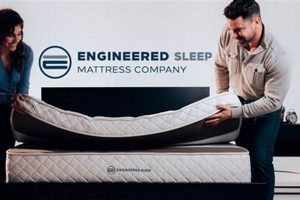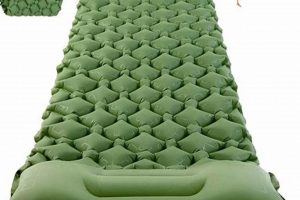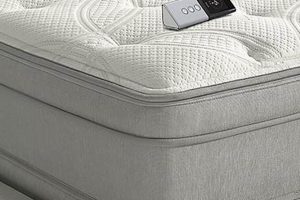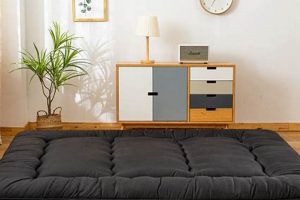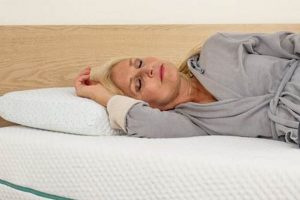This article focuses on a specific type of bedding designed for convertible furniture commonly found in recreational vehicles. This particular product serves a dual purpose, functioning as a seating cushion during the day and transforming into a sleeping surface at night. Examples include tri-fold mattresses, air mattresses designed for sofa beds, and custom-cut foam solutions tailored to fit RV sleeper sofas.
These products are vital for maximizing space and comfort within the confined environment of a camper. They offer the convenience of a bed without permanently sacrificing valuable living area. Historically, these types of mattresses were often thin and uncomfortable, but modern manufacturing techniques have led to improved options using memory foam, innerspring systems, and innovative designs that prioritize support and sleep quality. This evolution caters to the growing demand for comfort while traveling.
The following sections will delve into different types, materials, considerations for choosing the right option, and tips for maintenance and care to ensure longevity and sustained comfort. These aspects are crucial for optimizing the user experience in a recreational vehicle setting.
Selecting the Right Sleeper Surface for Your Camper
Optimizing comfort and space within a camper requires careful consideration of the sleeper surface employed in a sofa bed configuration. The following tips offer guidance for making informed choices.
Tip 1: Measure Accurately: Prior to purchase, measure the exact dimensions of the sleeper sofa when fully extended. Inaccurate measurements may result in a surface that does not properly fit the frame, leading to discomfort or damage.
Tip 2: Consider Material Density: Density is a key indicator of foam quality. Higher density foams tend to offer better support and durability, resisting compression and maintaining their shape over time.
Tip 3: Evaluate Thickness: Thickness directly impacts comfort. While thicker options often provide more cushioning, they can also reduce the overall space available within the camper when the sofa is in its seating configuration. A balance between comfort and practicality must be achieved.
Tip 4: Explore Different Foam Types: Memory foam conforms to the body, providing pressure relief. Latex offers a more responsive feel and is naturally hypoallergenic. Polyurethane foam is a budget-friendly option, but may not offer the same level of support or durability as other materials.
Tip 5: Check for Breathability: Proper ventilation is crucial to prevent moisture buildup and maintain a comfortable sleeping temperature. Look for materials or designs that promote airflow, such as open-cell foam or breathable covers.
Tip 6: Assess Weight Considerations: Weight is a significant factor in a camper setting. Heavier options may impact fuel efficiency and place additional strain on the sofa bed mechanism. Choose a material that is both comfortable and lightweight.
These considerations allow for the selection of a product that balances comfort, durability, and space efficiency, ultimately enhancing the travel experience.
The subsequent sections of this article will address maintenance strategies and longevity considerations to further maximize the value of your investment.
1. Dimensions
In the context of camper sleeper sofa mattresses, dimensions are a foundational consideration. Accurate measurements are not merely a convenience, but a necessity for optimal functionality and comfort within the confined space of a recreational vehicle. Mismatched dimensions can compromise both the sleeping experience and the seating arrangement.
- Length and Width of Extended Mattress
The length and width dictate the available sleeping area. These measurements must align precisely with the extended frame of the sofa bed. Insufficient length or width results in inadequate support for the sleeper, while excessive dimensions may prevent the sofa from fully extending within the camper’s confines. Understanding this facet is key for a restful sleep.
- Thickness of the Mattress
Thickness determines the level of cushioning and support. While a thicker design may seem preferable, it also reduces available headroom when the sofa bed is folded into its seating configuration. Furthermore, excessive thickness can hinder the folding mechanism’s smooth operation, leading to potential damage or inconvenience. Balancing thickness with practicality is vital.
- Folded Dimensions of the Sofa Bed
The dimensions of the sofa bed in its folded state are paramount for maximizing usable space within the camper. Bulky designs impede movement and limit storage capacity. Prioritizing a compact folded profile is crucial for maintaining an open and functional living area. This involves carefully considering the design and folding mechanism to minimize the sofa’s footprint when not in use.
- Compatibility with Camper’s Available Space
The final dimension to consider is the compatibility of the assembled bed in relation to the camper’s overall space. It should fit within the designated area without obstructing doorways, walkways, or access to other amenities. Overlooking this aspect can render the sofa bed impractical, regardless of its other desirable features. Proper planning is essential for seamless integration.
These dimensional considerations directly impact the practicality and comfort of a camper sleeper sofa mattress. Ignoring these factors can lead to a less-than-ideal travel experience. Prioritizing accurate measurements and spatial awareness is crucial for selecting a product that enhances, rather than detracts from, the enjoyment of the camper environment.
2. Material Composition
The selection of materials in a camper sleeper sofa mattress directly influences its comfort, durability, weight, and overall suitability for the demanding environment of recreational vehicle travel. The following details the impact of various material choices.
- Foam Density and Type
Foam density, measured in pounds per cubic foot, dictates the support and longevity of the mattress. High-density foams, such as memory foam or high-resiliency polyurethane, resist compression and provide superior support, but can also increase weight. Low-density foams are lighter and less expensive, but may degrade quickly and offer inadequate support for extended use. The type of foammemory, latex, or polyurethaneaffects the mattress’s contouring ability, temperature regulation, and allergenicity.
- Innerspring Systems
Certain mattresses incorporate innerspring systems for enhanced support and motion isolation. The gauge and coil count of the springs influence the firmness and responsiveness. However, innerspring systems typically add considerable weight and bulk, potentially impacting fuel efficiency and storage space within the camper. The presence of innerspring also increases the mattress’s rigidity, affecting its ability to conform to the contours of the sofa bed frame.
- Fabric Coverings
The fabric covering contributes to comfort, breathability, and ease of cleaning. Durable, stain-resistant fabrics, such as polyester blends or vinyl, are well-suited for the rigors of camper use. Breathable fabrics, like cotton or bamboo, enhance airflow and reduce moisture buildup, improving sleep quality. Some fabrics may also possess antimicrobial properties, inhibiting the growth of mold and bacteria in the humid environment of a camper.
- Fire Retardant Materials
Safety regulations often mandate the inclusion of fire-retardant materials in mattresses. These materials, whether chemically treated fabrics or inherent flame-resistant fibers, mitigate the risk of fire propagation in the event of an accident. While essential for safety, these treatments can sometimes affect the mattress’s breathability and overall comfort. It is vital to verify that fire retardant materials meet safety standards.
The interplay between these material components determines the overall performance of the camper sleeper sofa mattress. Careful consideration of these factors is vital for selecting a mattress that balances comfort, durability, safety, and practicality within the unique constraints of recreational vehicle travel.
3. Thickness
The thickness of a camper sleeper sofa mattress significantly influences both comfort and practicality within the limited space of a recreational vehicle. The correlation between thickness and comfort is generally positive, with thicker mattresses providing enhanced cushioning and pressure relief. However, this advantage is offset by the constraints imposed by the dual-purpose nature of the furniture. A mattress that is excessively thick reduces available headroom when the sofa is in its seating configuration. Furthermore, it may impede the folding mechanism, making the conversion between sofa and bed cumbersome. Conversely, insufficient thickness results in inadequate support, leading to discomfort and potential back strain. For instance, a mattress less than 4 inches thick may prove unsuitable for extended use, particularly for individuals requiring substantial support.
The optimal thickness represents a compromise between these competing demands. Many manufacturers offer camper sleeper sofa mattresses in the range of 4 to 6 inches, attempting to strike a balance between comfort and space efficiency. Materials such as memory foam and high-density polyurethane are frequently employed to maximize support within this limited thickness. Some designs incorporate a thinner profile with strategically placed support zones to address specific pressure points, thereby enhancing comfort without sacrificing space. For example, a 5-inch mattress with a memory foam topper may offer similar comfort to a thicker, all-foam mattress while maintaining a more compact profile when folded.
Ultimately, the ideal thickness depends on individual preferences and the specific dimensions of the camper. Careful consideration must be given to both the comfort needs of the occupants and the spatial constraints of the vehicle. Selection should involve physical testing, where possible, to assess the mattress’s comfort and ease of use within the intended environment. Ignoring the thickness factor can lead to either a cramped living space or a compromised sleeping experience, undermining the overall utility of the camper.
4. Weight Capacity
Weight capacity constitutes a critical specification for any camper sleeper sofa mattress, directly influencing both the longevity of the product and the safety of its occupants. Exceeding the stated weight limit can result in structural damage to the sofa bed frame and the mattress itself, leading to premature wear, sagging, and compromised support. For example, a sofa bed designed for a maximum weight of 300 pounds may experience accelerated deterioration if regularly subjected to a combined weight of 400 pounds. This can manifest as bent support bars, torn fabric, or compressed foam, ultimately reducing the product’s lifespan and rendering it less comfortable and safe.
Manufacturers establish weight capacity ratings based on extensive testing and engineering analysis. These ratings consider the materials used in the frame and the mattress, as well as the design of the folding mechanism. Ignoring the weight capacity introduces a heightened risk of component failure, potentially leading to injury if the sofa bed collapses during use. In real-world scenarios, families with multiple occupants or individuals with higher body weights must carefully evaluate the weight capacity of prospective sleeper sofas to ensure compatibility and safety. Overloading a sofa not only jeopardizes its structural integrity but also voids any warranties, leaving the consumer responsible for repair or replacement costs.
Therefore, understanding and adhering to the weight capacity of a camper sleeper sofa mattress is paramount for ensuring user safety, maintaining product integrity, and maximizing its lifespan. Failure to do so can lead to costly repairs, compromised comfort, and, in extreme cases, potential injury. Prior to purchase, buyers should meticulously review the manufacturer’s specifications and select a product that comfortably accommodates the intended users, taking into account not only their individual weights but also any potential fluctuations due to additional weight from bedding or other items placed on the mattress. This proactive approach safeguards the investment and promotes a safe and comfortable travel experience.
5. Foldability
Foldability is an intrinsic attribute of a camper sleeper sofa mattress, directly impacting its practicality within the confined spaces of recreational vehicles. The ability of the mattress to efficiently fold and unfold is not merely a convenience; it is a fundamental requirement for enabling the dual functionality of the sofa bed. A mattress that resists folding or requires excessive force to manipulate compromises the ease of conversion between seating and sleeping configurations, undermining the inherent space-saving benefits of the design. Consider, for example, a tri-fold mattress constructed with overly dense foam. Such a mattress may exhibit significant resistance when folding, demanding considerable physical effort and potentially leading to premature wear on the folding mechanism. The cause is the dense foam and the effect is the difficultly.
The design and materials used significantly affect foldability. Mattresses with segmented construction or those employing flexible materials like memory foam tend to fold more readily than those with a single, rigid core. Real-world examples include mattresses incorporating hinges or articulated joints to facilitate smooth folding, or those utilizing lightweight, pliable foam that compresses easily. The practicality of foldability extends beyond the initial setup. Frequent conversion between sofa and bed requires a mattress that can be easily managed. A cumbersome, difficult-to-fold mattress diminishes the usability of the sofa bed, potentially discouraging its use and negating its space-saving advantages.
In summary, foldability is a critical component of a camper sleeper sofa mattress, directly influencing its practicality and user-friendliness. The selection of materials and the design of the folding mechanism play crucial roles in determining the ease and efficiency of conversion. Neglecting this aspect can lead to a compromised user experience and reduced space efficiency within the camper. Challenges include balancing the need for a comfortable, supportive mattress with the requirements for easy folding. Understanding the connection between foldability and the overall functionality of the sofa bed is essential for making an informed purchasing decision and maximizing the utility of this dual-purpose furniture.
Frequently Asked Questions
This section addresses common inquiries concerning camper sleeper sofa mattresses, providing concise and objective information to aid in informed decision-making.
Question 1: What is the typical lifespan of a camper sleeper sofa mattress?
The lifespan varies depending on usage frequency, material quality, and maintenance practices. Generally, a well-maintained, high-quality mattress can last 5-7 years with regular use.
Question 2: Can a standard size mattress be used on a camper sleeper sofa?
Standard size mattresses are typically not compatible due to dimensional differences. Camper sleeper sofas often require custom-sized or specialized mattresses.
Question 3: How should a camper sleeper sofa mattress be cleaned?
Cleaning methods depend on the material. Regularly vacuuming is recommended. Spot cleaning with a mild detergent and water is suitable for most fabrics. Professional cleaning may be necessary for persistent stains or odors.
Question 4: What are the primary factors affecting the comfort of a camper sleeper sofa mattress?
Key factors include mattress thickness, foam density, support structure (if any), and breathability of the cover material.
Question 5: How does weight affect the performance and longevity of a camper sleeper sofa mattress?
Exceeding the manufacturer’s recommended weight capacity can lead to premature wear, sagging, and structural damage, ultimately reducing the mattress’s lifespan and comfort.
Question 6: What are some common indicators that a camper sleeper sofa mattress needs replacement?
Signs of necessary replacement include visible sagging, persistent discomfort despite adjustments, development of mold or mildew, and a significant loss of support.
These FAQs provide a foundational understanding of key considerations related to camper sleeper sofa mattresses. Addressing these aspects proactively can contribute to a more comfortable and enjoyable travel experience.
The following section will delve into specific maintenance strategies to prolong the life and enhance the comfort of your camper sleeper sofa mattress.
Concluding Remarks on Camper Sleeper Sofa Mattresses
This article has explored the multifaceted considerations surrounding the selection, utilization, and maintenance of a camper sleeper sofa mattress. Critical aspects such as dimensions, material composition, thickness, weight capacity, and foldability have been examined to underscore their impact on comfort, durability, and spatial efficiency within the confined environment of a recreational vehicle. Understanding these elements is paramount for maximizing the utility and lifespan of this essential piece of furniture.
The effectiveness of a camper sleeper sofa mattress directly influences the overall travel experience. Careful attention to the factors discussed herein will contribute to informed decision-making, ensuring a balance between comfort, practicality, and longevity. Prioritizing due diligence in the selection and maintenance of this component is essential for optimizing the enjoyment and functionality of any camper or RV setup.


